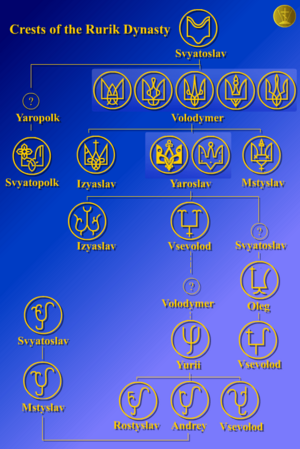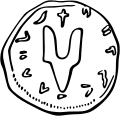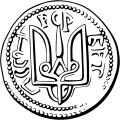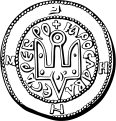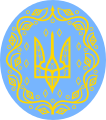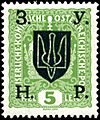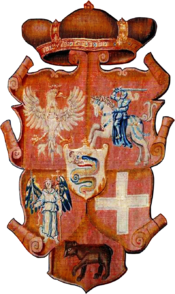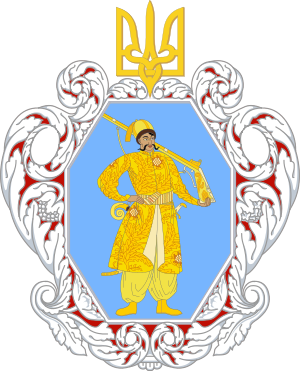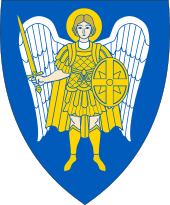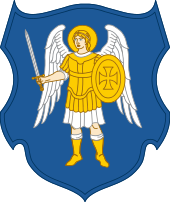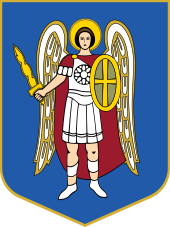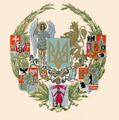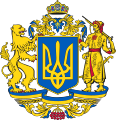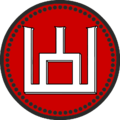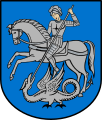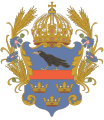Coat of arms of Ukraine facts for kids
Quick facts for kids Coat of arms of Ukraine |
|
|---|---|
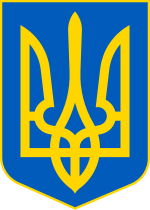 |
|
| Armiger | Ukraine |
| Adopted | 19 February 1992 |
| Blazon | Azure, a tryzub Or |
| Earlier version(s) |   |
| Use | Ukrainian People's Republic (1918–1920) |
The coat of arms of Ukraine is a blue shield with a gold trident. It is officially called the Emblem of the Royal State of Volodymyr the Great. Most people just call it the tryzub (Ukrainian: тризуб, meaning "trident"). This special symbol comes from the seal of Volodymyr the Great, who was the first Grand Prince of Kyiv.
The smaller version of the coat of arms was officially chosen on February 19, 1992. The country's constitution also talks about a larger coat of arms, but it hasn't been officially adopted yet. The small coat of arms was created by Andriy Grechylo, Oleksii Kokhan, and Ivan Turetskyi. You can see it on the Presidential Standard of Ukraine.
The trident wasn't seen as a national symbol until 1917. That's when a famous Ukrainian historian, Mykhailo Hrushevskyi, suggested it should be a national symbol. On February 25, 1918, the Central Rada (which was like the parliament) made it the coat of arms for the Ukrainian People's Republic. This republic existed for a short time.
During the Soviet era (1919–1991), Ukraine used symbols similar to those of the Soviet Union. These included a hammer and sickle over a rising sun. After Ukraine became independent in 1991, the tryzub was chosen as the new coat of arms in 1992.
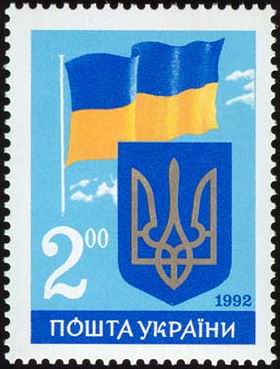
Contents
The Tryzub: Ukraine's Main Symbol
The modern "tryzub" symbol was chosen as the coat of arms for the Ukrainian People's Republic in February 1918. It was designed by Vasyl Krychevsky. This design has roots in the old seals of Kyivan Rus. The earliest known signs of this symbol are found on the seals of the Rurik dynasty.
This symbol was stamped on gold and silver coins made by Prince Volodymyr the Great (980–1015). He might have received this symbol from his family, like Sviatoslav I, and then passed it on to his sons. The tryzub was also found on bricks from the Church of the Tithes in Kyiv and on tiles from other old churches and castles. You can see it on many ancient items like pottery, weapons, rings, and old writings.
-
The seal of Sviatoslav the Brave (945)
-
Coin of Volodymyr the Great (980)
-
Coin of Yaroslav the Wise (1019)
-
The coat of arms of the Ukrainian People's Republic (1918)
-
The Greater coat of arms of the Ukrainian People's Republic, (1918)
-
The Ukrainian trident overprint of May 1919 on a five-heller stamp of Austria-Hungary
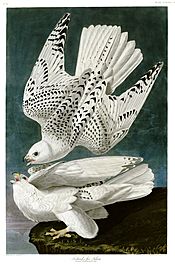
Historians have different ideas about where the tryzub came from. Some think it looks like a falcon, an arched bow, or even the Holy Trinity. Others believe it might be an anchor. Pictures of a flying falcon with a Christian cross above its head have been found in Old Ladoga, an early center of the Rurik dynasty. This type of falcon and cross also appeared on coins from a Viking king in Dublin.
Falconry, which is hunting with trained falcons, was a popular royal sport for many centuries in Europe. The gyrfalcon was seen as a royal bird. It is even mentioned in an old Ukrainian poem from the 12th century called The Tale of Ihor's Campaign.
Later versions of the tryzub among the Rurikids looked more like a two-pronged fork (bident) or the letter "У". This letter "У" in the modern Cyrillic alphabet makes the "u" sound, like in "Ukraine."
- Dimensioning of the coat of arms
Other Uses of the Tryzub
The Tryzub is often used in military symbols to remember the brave actions on the Eastern Front during World War II. Many units of the Italian Army have the Tryzub on their Coat of Arms. This is because they received awards for their service in Ukraine. The Tryzub is also the coat of arms for the city of Zaslawye.
Three-Fingered Salute
Sometimes, people use a three-fingered hand salute to look like the Tryzub. This was done in pro-independence protests in the late 1980s. It is also part of the logo for the Ukrainian Svoboda party.
Historical Coats of Arms of Ukraine
Kingdom of Ruthenia
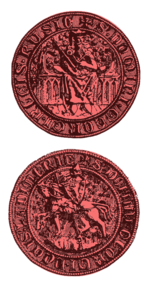
The Kingdom of Ruthenia had its own coat of arms since the 12th century. It featured a lion on a blue shield. The "Ruthenian lion" first appeared on the seal of King Yurii I in the early 14th century. This seal showed a king on his throne, and on the other side, an armed horseman holding a shield with a lion.
Later, on the seal of his son Lev II, only a lion was shown. This lion stood on its back legs, facing left. Lions as symbols of Ruthenia were also found on silver coins from the time of Lithuanian Prince Lubart, who was the last ruler of the Kingdom of Ruthenia.
After Poland took over Eastern Galicia, the lion coat of arms was changed and used as part of the Ruthenian Voivodeship. This symbol was later dropped when the territory became part of the Austrian Empire. After World War I, the Western Ukrainian People's Republic brought back the lion coat of arms. Today, the gold lion symbol is the coat of arms for the city of Lviv.
| Kingdom of Ruthenia | |||
|---|---|---|---|
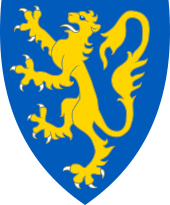 |
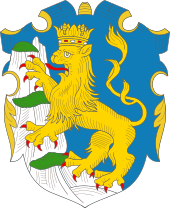 |
 |
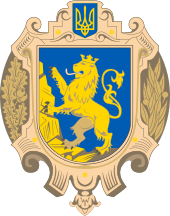 |
| Coat of arms of the Kingdom of Rus | Coat of arms of the Ruthenian Voivodeship | Coat of arms of the West Ukrainian People's Republic | Coat of arms of Lviv Oblast |
Cossack Hetmanate (Cossack with Musket)
A Cossack holding a musket was the symbol of the Zaporizhian Host. Later, it became the state symbol of the Hetmanate and the Ukrainian State. We don't know exactly when this symbol started, but it was first recorded in 1592. In 1767, this emblem was replaced by the Russian double-headed eagle.
The Cossack with a rifle was brought back by the Hetman of Ukraine Pavlo Skoropadsky in 1918. The symbol disappeared again until 2005, when it was suggested for the Great Seal of Ukraine.
| Cossack Hetmanate and Zaporizhia | |||
|---|---|---|---|
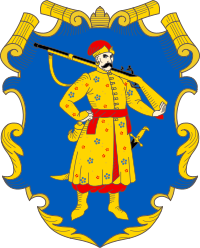 |
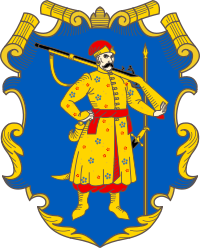 |
||
| Coat of arms of the Zaporizhian Host (Cossack Hetmanate) | Coat of arms of the Zaporizhian Host the Lower (Zaporizhian Cossacks) | ||
Designs by Heorhiy Narbut
Heorhiy Narbut was a Ukrainian artist who designed several versions of the coat of arms for the Ukrainian State in 1918. He used national symbols from the Hetman state of the Zaporizhzhia Army as his starting point. One design featured a Cossack dressed in gold on a blue shield. Above the Cossack, a golden tryzub was placed.
The tryzub became very popular in the Ukrainian People's Republic. It was even shown on the ruble coins introduced in December 1917. Narbut also used older symbols like the crossbow of Kyiv. The tryzub became a popular symbol and eventually became the small coat of arms of the Ukrainian People's Republic. It was also used by the Western region of the Ukrainian People's Republic and remained the coat of arms for the Hetman state and the Directorate of Ukraine.
Grand Duchy of Ruthenia (Archangel Michael)
The coat of arms of the Kyiv region, featuring Archangel Michael, became important during talks about the 1658 treaty of Hadiach. This treaty aimed to change the Commonwealth into a Polish–Lithuanian–Ruthenian Commonwealth. The symbol of Archangel Michael is sometimes confused with the symbol of Kyiv City itself. Before Ukraine became part of the Russian Empire in the 18th century, Kyiv City had a different symbol.
| Proposed / Drafts | ||||
|---|---|---|---|---|
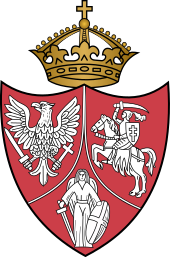 |
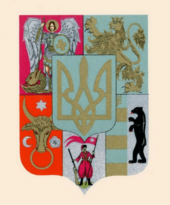 |
Link to file |
||
| Coat of arms of the January Uprising | Bytynskyi coat of arms of Ukraine | Kokhan coat of arms of Ukraine | ||
Carpathian Ruthenia (Red Bear)
This coat of arms was created after First World War, when Carpathian Ruthenia became part of the new country of Czechoslovakia. It was designed in 1920 by a Czech historian named Gustav Friedrich. The people of Ruthenia were promised self-governance within Czechoslovakia, so a coat of arms was made for their land.
| Carpathian Ruthenia | |||
|---|---|---|---|
 |
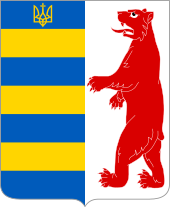 |
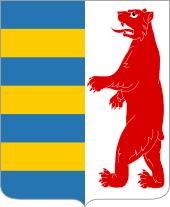 |
|
| Middle coat of arms of Czechoslovakia | Coat of arms of Carpatho-Ukraine | Coat of arms of the current Zakarpattia Oblast | |
The coat of arms shows the Ukrainian colors of blue and gold on one side. On the other side, it has a red bear on a silver background. The bear might represent the wildlife in the Carpathian mountains. The horizontal lines might have been inspired by the coat of arms of Hungary, which the territory used to belong to.
The short-lived state of Carpatho-Ukraine also used these arms in 1939. They added the Ukrainian Tryzub to the blue field. Since this territory is now the Zakarpattia Oblast, the oblast uses a similar coat of arms, but without the trident.
Ukrainian Soviet Socialist Republic
The coat of arms of the Ukrainian Soviet Socialist Republic was adopted on March 14, 1919. It was changed several times over the years. The version from 1949 was based on the coat of arms of the Soviet Union. It showed a hammer and sickle with a sunrise on a shield, topped with a red star. Wheat ears were on the sides.
The symbol also included the Soviet Union's motto, "Workers of the world, unite!" in both Ukrainian and Russian. After Ukraine became independent on August 24, 1991, it kept the Soviet emblem for a short time. But in 1992, it was changed to the current coat of arms of Ukraine, the tryzub.
| Emblem of the Ukrainian Soviet Socialist Republic | |||
|---|---|---|---|
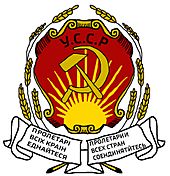 |
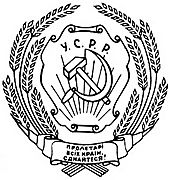 |
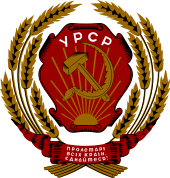 |
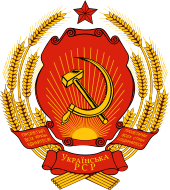 |
| 1919–1929 | 1929–1937 | 1937–1949 | 1949–1992 |
Greater Coat of Arms of Ukraine
In 1917, Mykhailo Hrushevsky, who was the President of the Central Rada, suggested a Great Coat of Arms. It would have a single shield with a dove and olive branch on top. The shield itself would be divided into five parts. In the middle, there would be a smaller shield showing a plough, which symbolizes peaceful work. Around it would be old Ukrainian state symbols, like the tryzub of Volodymyr the Great, a lion, a cossack with musket, a crossbow, and the lion of Lviv.
The current Constitution of Ukraine mentions that there should be a Great Coat of Arms. However, it has never been officially adopted. In proposed designs, the shield is held up by a lion from the Galician Coat of Arms on the left. On the right, there is a Cossack in traditional clothes holding a musket, which is a symbol of the Cossack Hetmanate. The coat of arms is topped with the crown of Volodymyr the Great, showing Ukraine's sovereignty (its independence). It is also decorated with viburnum berries and wheat at the bottom.
Since Ukraine became independent in 1991, the Ukrainian government has tried four times to create an official Great Coat of Arms, but they have all failed. For the Great Coat of Arms to be officially adopted, two-thirds of the members of the Verkhovna Rada (the Ukrainian parliament) must vote for it. That's 300 votes!
On August 25, 2020, the Verkhovna Rada asked the government to get an official Great Coat of Arms ready for Ukraine's 30th anniversary of independence. On August 24, 2021, the day of the 30th anniversary, the Verkhovna Rada voted in favor of a law to establish an official Great Coat of Arms.
Images for kids
-
City of Lviv in the Soviet Union (1967–1990)
-
Variation of Pogon Ruska for the city of Kamianets-Podilskyi in (1374–1796) until occupation of Podolia by Russian Empire
-
Proposed coat of arms for the Polish–Lithuanian–Ruthenian Commonwealth during the January Uprising
See also
 In Spanish: Escudo de Ucrania para niños
In Spanish: Escudo de Ucrania para niños
- Armorial of Ukraine
- National symbols of Ukraine
- Symbols of the Rurikids
- Columns of Gediminas
- Cossack with musket
- Flag of Ukraine
- Trishula, Trident of Poseidon


